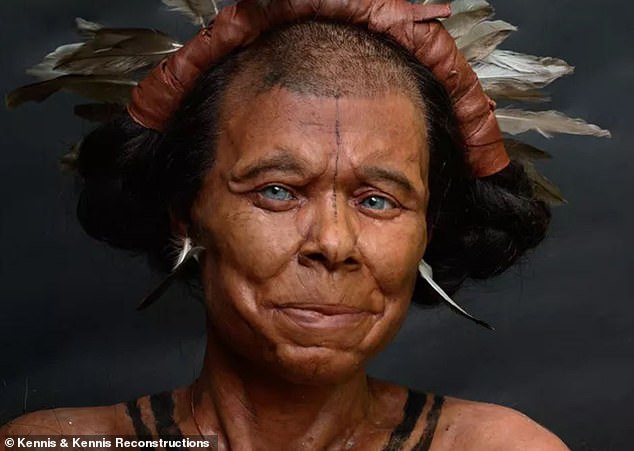
DNA Reconstruction Reveals 10,000-Year-Old Woman with Striking Blue Eyes and Light Skin
Meet the Margaux Woman: A 10,500-Year-Old Face Brought to Life
At first glance, this striking image resembles a modern-day tribesperson with a feathered headdress and piercing gaze. But it’s actually a hyper-realistic reconstruction of a woman from Belgium who lived 10,500 years ago. Known as the Margaux woman, her remains were discovered nestled in a cave in the Meuse Valley, offering a rare glimpse into Europe’s ancient hunter-gatherer communities.
A Face from the Stone Age
Scientists extracted DNA from her skull, revealing she had light skin and blue-gray eyes—features slightly lighter than expected for her time. Dutch paleo-artists Adrie and Alfons Kennis, famed for reconstructing historical figures like Ötzi the Iceman, crafted her lifelike bust using resin and silicone. The result shows a middle-aged woman with a shaved head adorned with a leather band, ochre and charcoal shoulder markings, and an expression reflecting the hardships of Mesolithic life.

DNA Unveils Unexpected Diversity
Her genetic analysis surprised researchers. “Her skin tone was lighter than many contemporaries, suggesting greater diversity in pigmentation than assumed,” said geneticist Maïté Rivollat. Like Britain’s Cheddar Man (a 10,000-year-old ancestor with dark skin and blue eyes), she belonged to Western Europe’s hunter-gatherer populations. However, her lighter complexion challenges previous assumptions about Stone Age Europeans.
Discovered in 1988, the Margaux cave held her skull alongside fragmented remains of eight others. Decades later, advanced DNA techniques mapped her appearance. Anthropologist Isabelle De Groote noted she died between 35–60 years old, though her skeleton shows no signs of trauma or disease.
Life in Mesolithic Belgium
Imagine Belgium 10,500 years ago: dense forests, winding rivers, and nomadic clans thriving on wild game, fish, and plants like hazelnuts. The Margaux woman’s group moved seasonally, returning to campsites like Abri du Pape. They crafted tools from flint and bone, wore animal hides, and possibly kept dogs. “Their lives were intertwined with nature,” De Groote explains. Burials in caves suggest deep ties to ritual sites.

Naming the Past
The public is invited to name her through an online poll. Choices include Margo (after her cave), Freya (referencing local hills), or Mos’anne (for the river basin). Voting runs until June’s end via the ROAM project’s website. Starting September 2025, her reconstruction will tour Belgian museums, including Ghent University and the Gallo-Romeins Museum.
A Window into Ancient Europe
This project, blending archaeology, genetics, and art, highlights our shared humanity. Like Cheddar Man (whose sculpted face revealed a darker complexion), the Margaux woman reshapes our understanding of ancient diversity. Their stories remind us that migration and adaptation have always defined human history.

In Brief:
- Who? A 10,500-year-old hunter-gatherer from Belgium.
- Appearance: Light skin, blue-gray eyes, shaved head with tribal adornments.
- Legacy: Challenges assumptions about ancient European diversity.
- See Her: Touring Belgian museums starting September 2025.
By merging science and artistry, the Margaux woman bridges millennia, inviting us to see Stone Age Europe through her eyes.


